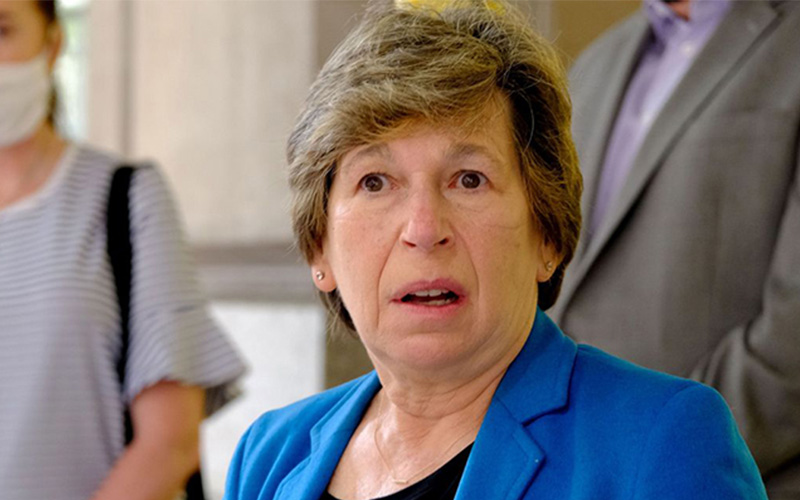Summary
- AFT president Randi Weingarten’s teaching experience is very limited. While she describes having worked as a New York City public school teacher for six years, she only worked as a regularly appointed full-time teacher for three years, after having spent three years as a per diem substitute.
- Documents recently obtained by the Freedom Foundation show that Weingarten has been on union leave from her teaching position for the past quarter century.
- Additional documents show that the Teacher Retirement System of the City of New York has credited Weingarten with nearly 11-and-a-half years of service credit for time spent out of the classroom on full-time union leave as an officer for the United Federation of Teachers.
- Due to her limited time in the classroom, Weingarten only became vested and eligible for pension benefits because of service credit accrued for her time working as a union officer.
- Weingarten’s pension benefits could easily cost taxpayers more than $200,000.
- Weingarten has simultaneously received a generous salary and retirement benefits while employed at UFT and AFT.
Introduction
During an April 26 hearing by the U.S. House Oversight Select Subcommittee on the Coronavirus Pandemic, president of the American Federation of Teachers (AFT) Rhonda “Randi” Weingarten testified about her union’s role in the prolonged closure of public schools during the COVID-19 crisis.
Weingarten has led AFT since 2008—far longer than her counterpart, Rebecca Pringle, has helmed the National Education Association (NEA), the other national teachers union—allowing Weingarten to develop into a media and political fixture
While AFT is definitely the smaller of the two, with 1.7 million members compared to the 2.9 million claimed by NEA, it remains a potent political force with no compunction about throwing its considerable weight around.
In fact, the hearing focused on AFT’s role in advocating for changes to the school reopening guidance eventually released by the Centers for Disease Control and Prevention in early 2021 that would have made renewed school closures more likely. In some cases, CDC officials appeared to incorporate AFT edits into their official guidance word-for-word.
Amid questioning by the committee, Weingarten repeatedly cited her experience as a public-school teacher at Clara Barton High School in New York City.
However, as an attorney by trade, Weingarten has spent most of her career in the law and as a full-time union officer. Weingarten’s AFT biography buries her limited teaching experience in the last sentence of the 17th paragraph.
While the limited duration of Weingarten’s service as a public-school teacher has been broadly noted before, the fact that she secured a generous New York City public pension based on that limited experience has not been previously documented.
Union president, or teacher on leave?
When forced to acknowledge during the hearing that she hasn’t taught since June of 1997, Weingarten rejoined by noting, curiously, “I am actually on leave from my teaching position.”
On leave? How can a New York City public-school teacher be “on leave” from a position in which she was last employed a quarter of a century ago? And what does being “on leave” even mean?
As with so many oddities in public education, turning to the union contract provides the answer.
New York City’s public-school teachers are represented by the United Federation of Teachers (UFT), one of AFT’s largest affiliates.
Article 19(C) of the collective bargaining agreement between UFT and the New York City School District Board of Education—a 238-page behemoth regulating the operation of the city’s schools in minute detail—provides:
“Employees who are officers of the Union or who are appointed to its staff shall, upon proper application, be given a leave of absence without pay for each school year during the term of this Agreement for the purpose of performing legitimate duties for the Union.”
Records provided to the Freedom Foundation by the New York City Department of Education in November 2022 confirm Weingarten was one of 89 public school teachers on union leave pursuant to this provision.
Many government union collective bargaining agreements around the country provide paid “release time” for union officers, allowing public employees like teachers to be “released” from the duties for which they were hired to work on union business, sometimes full-time, while continuing to receive their taxpayer-funded salary and/or benefits.
While, in this case, the union contract specifies that teachers on union leave won’t be paid wages, that doesn’t mean Weingarten’s union leave is cost-free for taxpayers.
Additional language in the union contract provides that, “No more than 32 leaves of absence without pay shall be granted for each school year” but, “Effective September 2, 2014, the number of leaves of absence without pay shall increase by eighteen (18).” Importantly, the contract notes that, “The UFT agrees to pay the cost of the Board [of Education]’s pension contributions and FICA taxes for individuals on these eighteen (18) additional leaves,” implying that pension contributions are made at taxpayer expense for the first 32 employees on leave in any given school year.
Records obtained by the Freedom Foundation from the Teachers’ Retirement System of the City of New York (TRSNYC) show that Weingarten’s taxpayer-funded pension will be calculated on the basis that she has worked full-time for more than 15 years as a public-school teacher in New York City schools when, in reality, she only worked about four.
Weingarten’s limited tenure as a public-school teacher
Weingarten began working for UFT in 1986, serving as legal counsel to UFT president Sandra Feldman until 1998, when she succeeded Feldman as president of the union.
Regarding her limited teaching experience, AFT’s biography of Weingarten states only that she was a “teacher of history at Clara Barton High School in Brooklyn’s Crown Heights neighborhood from 1991 to 1997…”
It’s not clear how Weingarten could serve as Feldman’s UFT staff attorney while simultaneously teaching full-time and, over the years, some have questioned Weingarten’s experience in the classroom.
In 1998, Michael Shulman, Weingarten’s opponent in the election to succeed Feldman as head of the UFT, told the New York Times that Weingarten was not “a real teacher” since, as he claimed, “She worked five months full time that I’ve been aware of, in 1992, at Clara Barton High School. Since then, she taught maybe one class for 40 minutes a day.”
An otherwise glowing profile of Weingarten by the Jewish publication Forward in 2010 acknowledged,
“Weingarten’s roots in her own union’s rank and file and the day-to-day work of education are not overwhelming. She worked as a teacher in Brooklyn for six years, but was only full-time for half of that period.”
And in 2011, the nonprofit Education Action Group (EAG) responded to Weingarten’s claim that education reform advocates “wouldn’t last 10 minutes in a classroom” by questioning the longevity of Weingarten’s own teaching career and suggesting she only taught as a substitute.
The allegations drew a response from Weingarten, posted on AFT’s Facebook page, in which she simply reiterated that she “taught Social Studies at Clara Barton High School in New York City from 1991 to 1997.”
The Freedom Foundation’s review of documents from Weingarten’s personnel file—first posted online, but not extensively analyzed, by EAG in 2011—suggests she worked part-time as a per diem substitute from September 1991 through August 1994, and as a “regularly appointed” teacher from September 1994 until the spring of 1997:
- A largely redacted “application for pedagogical license or certificate” submitted by Weingarten to New York City Public Schools and dated August 20, 1991, indicates that, at the time of the application, Weingarten was employed 40 hours per week, 52 weeks per year as counsel to the UFT president.
- Weingarten submitted another “application for pedagogical license or certificate,” dated March 30, 1994, for a “regular license for appointment” as a junior high social studies teacher. In the employment history section of the application, Weingarten noted she had worked two hours per day, 180 days per year as a “regular substitute” at Clara Barton since September 1991. She also reported working on “student learning” for two to three hours per day for 12 days between May and June 1994.
- An application for a salary differential submitted by Weingarten on August 31, 1994, indicated that she was certified as a “per diem substitute” on September 24, 1991, and would become a “regularly appointed” teacher effective September 12, 1994.
- An “application for allowable salary credit for prior experience” submitted by Weingarten on September 21, 1994, indicated Weingarten worked as a “per diem” part-time substitute from September 1991 through June 1994.
- Weingarten’s personnel file contains a “certificate to serve as a substitute” dated October 8, 1994, and effective from May 11 through August 31, 1994.
- Lastly, a letter to Weingarten from the Board of Education dated July 11, 1997, stated that,
“…as a result of your failure to complete full preparation requirements for licensure by the June 30, 1997 deadline, your regular license will be terminated prior to the start of the 1997-1998 school year. Consequently, you will revert to regular substitute status and your salary code will be reduced to Step 4A… Please be further advised that although the termination of your license will adversely effect [sic] your appointment and salary status, this action will not effect [sic] your employment in your current district and school. Therefore, you have the option to continue serving in your present position as a full-time regular substitute until such time that reinstatement is possible.”
(Emphasis in original).
Weingarten’s taxpayer-funded pension benefits
Documents obtained by the Freedom Foundation from TRSNYC indicate the pension system has counted 11 years of Weingarten’s time on union leave toward her “service credit,” dramatically increasing her pension benefits. In fact, it appears Weingarten would not have become vested in the pension system at all but for the service credit she accumulated while on union leave.
While substitute teachers are not eligible for pensions, “Appointed teachers and pedagogues in New York City’s public schools automatically become TRS members as of their appointment date,” explains TRSNYC.
Accordingly, the “2022 Annual Benefits Statement” issued to Weingarten by TRSNYC lists her membership date in the pension system as October 1, 1994, reflecting her transition from a per diem substitute to a regularly appointed, full-time teacher at that time.
The statement further shows that Weingarten has accumulated 15 years, five months, and seven days’ worth of service credit in the Tier IV pension plan—the plan in which New York City teachers who started working between 1983 and 2012 participate. Tier IV members are vested (become eligible for pension benefits) after accumulating five years of service credit and may retire with full benefits at age 62 (Weingarten is 65).
Weingarten’s total service credit consists of:
- 14 years, five months and two days of “membership service,” defined as, “Any credited service you performed as a TRS member.” Accumulation of membership service is mandatory and automatic. Teachers can accumulate no more than one year of service credit per school year worked and accrue less if employed part-time. The approximately three years Weingarten spent working, presumably full-time, as a regularly appointed teacher would have counted as three years of “membership service.”
- Nine months and 25 days of “prior service,” and two months and 10 days of “Amman service.” Unlike membership service, prior service and Amman service are types of optional service credit plan members may purchase by paying the employee portion of the pension contributions that would have been required of them if a member of the plan at the time, plus interest. TRSNYC explains, “If you served in a substitute teaching position prior to joining TRS, you may receive prior service credit for the service. If you render substitute teaching service during an unpaid leave of absence or after separating from service and you return to active service in a TRS-eligible position, you may receive Amman credit for the service.” Apparently, Weingarten opted to purchase service credit for her time spent working as a substitute from 1991-1994 upon becoming a member of the pension plan as a regularly appointed teacher in 1994.
Assuming Weingarten worked full-time from 1994-1997, she would have accumulated three years of service credit. Add to that the prior service and Amman service credit she apparently purchased for work as a substitute, and her total service credit would amount to just over four years—short of the five required to become vested.
Interestingly, Weingarten’s 2022 annual benefits statement reported no new service credit in the 2021-22 school year, indicating the service credit for her union leave ended at some point.
Most likely, the 11-and-a-half years of excess service credit reflected in Weingarten’s pension derive from time spent out of the classroom on union leave as treasurer and then president of UFT from 1997 until her election as AFT president in 2008, without which Weingarten would not have been eligible for pension benefits as a New York City school teacher.
What will Weingarten’s pension cost taxpayers?
While Weingarten’s pension benefits and the amount of which will ultimately be borne by taxpayers cannot be precisely calculated, reasonable estimates suggest it could amount to hundreds of thousands of dollars.
First, TRSNYC explains that,
“Service retirees receive monthly payments of a QPP [Qualified Pension Plan] retirement allowance for life. The retirement allowance under each tier is calculated based on a member’s Total Service Credit and Final Average Salary (FAS)… A member’s Final Average Salary is the highest average of wages earned during any continuous period of employment for which the member receives three years of service credit.”
Weingarten’s 2022 annual benefits statement indicates her last reported salary as a New York City teacher was $64,313.
Second, pension benefits for Tier IV members with less than 20 years of service credit are calculated by multiplying 1.6 percent of final average salary by years of service credit.
Thus, assuming Weingarten’s FAS was $60,000, her annual pension benefits would amount to more than $15,300 per year (.0166 x $60,000 FAS x 15.4 years of service credit). If she retired at age 70 and collected the pension for 15 years, her total pension benefits would amount to $230,000, not including annual cost-of-living adjustments.
Further, taxpayers will bear nearly the entire cost of Weingarten’s eventual pension benefits. Tier IV members must contribute 3 percent of their salary to the pension fund until they accumulate 10 years of service credit. Assuming Weingarten was paid $240,000 in wages during her time as a New York City school teacher ($60,000 for her time as a substitute and an average of $60,000 for each of the three years employed as a regularly appointed teacher), her total contributions would have amounted to only about $7,200.
Of course, as a full-time UFT and now AFT officer and employee, Weingarten is also generously compensated at her members’ expense and will receive a union retirement, as well. AFT’s 2020 tax return discloses that Weingarten was paid $543,562, including $57,000 in “retirement and other deferred compensation,” that year alone, while UFT financial disclosures to the U.S. Department of Labor suggest Weingarten likely received a union retirement for her time as a UFT officer, too.
Is this legal?
Weingarten’s accrual of public pension benefits while on union leave appears to exist in a legal gray zone. Article 19(c) of the union contract between UFT and the New York City Board of Education notes that, “The Board agrees to recommend to the Teachers’ Retirement Board that the time spent on leave of absence pursuant to this section be granted as service credit for retirement purpose,” implying that, at least at one point, time spent on union leave did not count as retirement service credit. Apparently TRSNYC has since changed its tune.
However, the Freedom Foundation was unable to identify any provision in TRSNYC regulations explicitly authorizing service credit for teachers on union leave. At the same time, the Freedom Foundation is unaware of any applicable New York law prohibiting public employees from receiving pension service credit while on union leave, and the teachers’ union collective bargaining agreement with the New York City Board of Education suggests the practice is not uncommon.
Conclusion: Government unions are the problem
From supporting prolonged COVID-19 school closures and teacher strikes to opposing school choice and promoting extreme ideology in American classrooms, Randi Weingarten has consistently placed her union’s interests above students, families and sometimes even her own members.
While no one can begrudge Weingarten the payment of any pension benefits she might have earned while actually teaching, the public should not be expected to pick up the tab for her time spent out of the classroom advocating against their interests at the helm of UFT and AFT, especially since she was simultaneously receiving a union retirement.
Disturbingly, Weingarten’s situation is far from the worst example of taxpayers footing the bill for union work. Hundreds if not thousands of federal employees use “official time” to work full-time on union business while receiving their full, taxpayer-funded salary and benefits. Similar “release time” arrangements proliferate in state and local government union contracts as well.
Still, Weingarten’s case is a prime example of how government unions around the country have managed to force taxpayers to subsidize their extreme, one-sided political advocacy, and it’s high time federal and state lawmakers stand up to union influence. Ending paid union leave would be a great place to start.









